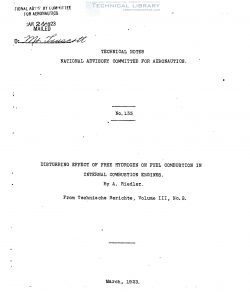naca-tn-133
- Version
- 163 Downloads
- 312.47 KB File Size
- 1 File Count
- November 3, 2016 Create Date
- November 3, 2016 Last Updated
National Advisory Committee for Aeronautics, Technical Notes - Disturbing Effect of Free Hydrogen on Fuel Combustion in Internal Combustion Engines

Experiments with fuel mixtures of varying composition, have
recently been conducted by the Motor Vehicle and Airplane Engine
Testing Laboratories of the Royal Technical High School in Berlin
and at Fort Hahneberg, as well as at numerous private engine works.
The behavior of hydrogen during combustion in engines and its
harmful effect under certain conditions, on the combustion in the
engine cylinder are of general interest. Some of the results of
these experiments are given here, in order to elucidate the main
facts and explain much that is already a matter of experience
with chauffers and pilots.
Immediately after the mobilization of the army, in 1914, a
shortage of gasoline was experienced, but it was believed that
possibly the situation could be met by intensifying the production
of benzol throughout the country. IThe military authorities were
offered various fuel mixtures which, at first, were not designat-
ed as "substitutes," but as "improved“ and “enriched" fuels. These
were mostly l t l benzol—alcohol mixtures, with a "secret addi-
tion," which was to be introduced in powder form and dissolved
immediately before use.
Preliminary investigation showed that these so—oalled "en—
richers" were carriers of oxygen or hydrogen. In engine tests,
however, it was found, without exception, that both the power out—
put and fuel consumption were more unfavorable with these added
substances than without them, and that, therefore, the "enriching
mediums" had no practical value.
The reason for decreased output and increased fuel consump—
tion, in so far as it was affected by the presence of the oxygen __
carriers, was not investigated, as it was considered too trivial
to warrant extensive research, apart from the fact that the quan-
tity of "secret“ substances available was also insignificant.
| File | Action |
|---|---|
| naca-tn-133 Disturbing Effect of Free Hydrogen on Fuel Combustion in Internal Combustion Engines.pdf | Download |

Comment On This Post